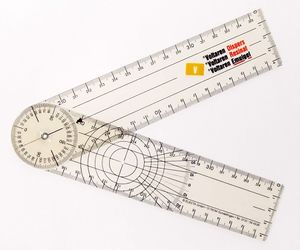Goniometry: Knee Flexion: Difference between revisions
Claire Knott (talk | contribs) No edit summary |
No edit summary |
||
| Line 1: | Line 1: | ||
== Introduction == | |||
[[File:Medizinischer Goniometer.jpg|thumb|Goniometer]] | |||
The [[knee]] joint's [[Range of Motion|range of motion]] (ROM) is an important clinical parameter used in [[Knee Examination|knee assessment]]. Knee flexion can be measured with a [[goniometer]]. The goniometer can simply measure the joint angles. It has some limitations not allowing the clinician to analyse the ROM and track the knee joint during eg [[Walking - Muscles Used|walking]] or maximum squat. Motion capture devices are mainly used to analyse the patient's [[gait]] and assess the condition of the joints and bones. | |||
== Anatomical Movement == | == Anatomical Movement == | ||
Knee flexion | Knee flexion | ||
Revision as of 06:18, 17 February 2022
Introduction[edit | edit source]
The knee joint's range of motion (ROM) is an important clinical parameter used in knee assessment. Knee flexion can be measured with a goniometer. The goniometer can simply measure the joint angles. It has some limitations not allowing the clinician to analyse the ROM and track the knee joint during eg walking or maximum squat. Motion capture devices are mainly used to analyse the patient's gait and assess the condition of the joints and bones.
Anatomical Movement[edit | edit source]
Knee flexion
Testing position[edit | edit source]
Patient is in prone with test-side ankle off plinth and leg in extension.
Goniometer Placement[edit | edit source]
| AXIS LOCATION | STATIONARY ARM | MOVEMENT ARM |
|---|---|---|
| lateral epicondyle of the femur | along the femur to the greater trochanter | along the fibula to lateral malleolus |
Expected Findings[edit | edit source]
Expected range of motion in prone is 135 degrees[1]
References[edit | edit source]
- ↑ Norkin CC, White DJ. Measurement of joint motion: a guide to goniometry. FA Davis; 2016 Nov 18.







